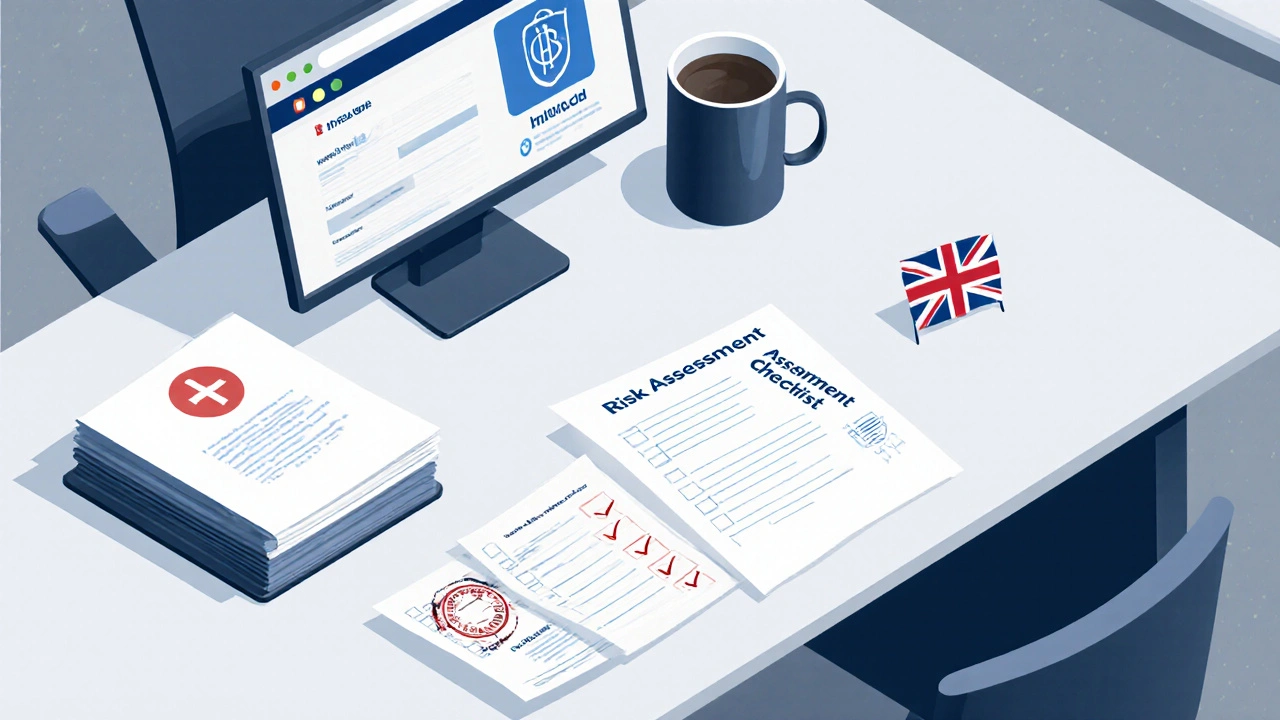Employer Liability Insurance Premium Calculator
This calculator estimates your annual premium based on UK business factors. Minimum legal coverage is £5 million per claim under the Employers' Liability Act 1998.
Estimated Annual Premium
Based on typical UK business rates. Actual premiums vary by insurer.
Note: Minimum legal coverage is £5 million per claim under the Employers' Liability Act 1998.
Did you know that more than 90% of UK employers face a workplace injury claim at least once in their first five years? If you’re running a business, that statistic should make you think twice about leaving a gap in your protection.
What is employer liability insurance?
Employer liability insurance is a type of compulsory business insurance in the United Kingdom that covers legal costs and compensation if an employee suffers a work‑related injury or disease. In plain English, it’s the safety net that pays the bills when someone gets hurt on the job and decides to take legal action.
Why the law demands it
The Employers' Liability (EL) Act 1998 requires most UK employers to have a minimum level of cover. The legal backbone is the Health and Safety at Work Act 1974 which places a duty of care on employers to protect their staff from avoidable harm. Failure to comply can lead to hefty fines, prosecution, and even business closure.
Who needs it?
Any organisation with at least one employee - whether full‑time, part‑time, or casual - must hold the policy. This includes freelancers hired through an agency, apprentices, and even volunteers who receive a small stipend. The only exemptions are very small sole traders with no staff and specific charity volunteers who are covered by separate schemes.
What does the cover include?
At its core, the policy pays for:
- Legal defence costs if a claim goes to court.
- Compensation for personal injury, disease, or death caused by the employer’s negligence.
- Medical expenses and rehabilitation costs directly linked to the claim.
Notice that it does NOT cover property damage, loss of income for the employee, or claims arising from intentional wrongdoing. Those fall under other policies like public liability or professional indemnity.

How much cover do you need?
The legal minimum is £5million per claim, but many insurers suggest £10million or more for larger firms. A common rule of thumb is to match the cover to the scale of your workforce and the risk level of your industry. Construction sites, manufacturing plants, and laboratories typically opt for higher limits than office‑based businesses.
Factors that shape the premium
Premiums are not a one‑size‑fits‑all number. Insurers look at several risk indicators:
- Industry risk profile - high‑hazard sectors attract higher rates.
- Number of employees - more staff means greater exposure.
- Claims history - a clean record can shave up to 20% off the quote.
- Risk management practices - documented risk assessments that show you regularly identify and mitigate workplace hazards can earn discounts.
- Policy limits - raising the limit from £5million to £10million will increase the premium proportionally.
On average, a small retail shop pays around £150‑£300 per year, while a medium‑size manufacturing firm can expect £2,000‑£5,000 annually.
Choosing the right provider
Not all insurers are created equal. Here’s a quick checklist to help you vet options:
- Financial stability - look for ratings from agencies like Standard & Poor’s.
- Claims handling speed - the Royal Society for the Prevention of Accidents (RoSPA) rates insurers on their efficiency and fairness in dealing with claims for the most recent year.
- Policy wording - ensure there are no hidden exclusions for the types of injuries common in your sector.
- Broker support - an experienced insurance broker can negotiate better terms and explain complex clauses adds value beyond the raw price.
- Online portal - modern providers let you manage certificates, submit claims, and track status digitally.
How a claim works
When an employee files a claim, the process typically follows these steps:
- Notification - the employee informs you and the insurer within the policy’s time limits (usually 90 days).
- Investigation - the insurer gathers evidence, often requesting the workplace injury report, medical records, and witness statements.
- Legal assessment - if the case proceeds, lawyers are appointed to defend or negotiate.
- Settlement - an agreed compensation figure is paid, or a court judgment is enforced.
- Post‑claim review - you’ll need to update your risk controls to prevent recurrence.
Important tip: keep thorough documentation from day one. A well‑recorded incident can dramatically reduce legal costs.

Employer liability vs. other business insurances
| Feature | Employer Liability | Public Liability | Professional Indemnity |
|---|---|---|---|
| Primarily protects against | Employee injury or disease | Third‑party injury or property damage | Claims of negligence in professional advice |
| Legal requirement | Yes, for most employers | Not mandatory (common for public‑facing firms) | Not mandatory (essential for consultants, lawyers, architects) |
| Typical minimum limit | £5million per claim | £1million per claim | £250,000 per claim (industry‑specific) |
| Common exclusions | Intentional wrongdoing, contract breaches | Employee injuries, contractual liabilities | Known pre‑existing errors, deliberate misconduct |
Understanding where each policy fits helps you avoid costly coverage gaps.
Common pitfalls and how to avoid them
- Assuming ‘minimum cover is enough’ - many businesses underestimate the true cost of a severe claim, which can exceed £1million in compensation alone.
- Neglecting policy renewals - a lapse can expose you to unlimited liability.
- Over‑relying on generic templates - always read the fine print; some clauses limit cover for repetitive strain injuries.
- Skipping risk assessments - insurers often demand evidence of proactive safety measures before granting discounts.
Take action now: schedule a quarterly safety audit, update your employee handbook, and keep your insurance broker in the loop.
Bottom line for UK employers
Employer liability insurance isn’t just a legal checkbox; it’s a financial shield that can keep a business afloat after a serious workplace incident. By matching coverage to risk, choosing a reputable insurer, and maintaining solid health‑and‑safety practices, you protect both your people and your bottom line.
Frequently Asked Questions
Is employer liability insurance the same as public liability?
No. Employer liability covers claims from employees for work‑related injuries or diseases, while public liability protects against claims from third parties who are not staff.
What is the legal minimum cover required?
The law mandates at least £5million of cover per claim for most employers under the Employers' Liability (EL) Act 1998.
Can a sole trader with no staff avoid this insurance?
If you truly have no employees, you are exempt. However, hiring even one part‑time worker instantly creates a legal obligation.
How often should I review my policy?
At least once a year, or whenever you add staff, change your business activities, or experience a claim.
What documents do insurers typically request after a claim?
They usually ask for the incident report, medical certificates, witness statements, risk assessment records, and any correspondence with the employee.



Comments (11)
Jack Gifford October 5 2025
Hey folks, the calculator looks slick but remember the premium you see is just a ballpark. Real insurers will dig into your claims history, safety docs, and even your supply chain. If you’re in a low‑risk sector like retail, you’ll probably stay near the base rate, but construction firms should expect a heftier tag. It never hurts to shop around and ask for a detailed quote before signing anything.
Sarah Meadows October 12 2025
Honestly, the UK’s regulatory framework is a relic that stifles entrepreneurial vigor. Your “premium” is just a fiscal leech funded by taxpayers, and the jargon they spew-like “risk exposure” and “actuarial underwriting”-is pure bureaucratic obfuscation. Companies should lobby to slash the statutory £5 million minimum and let the free market dictate coverage.
Nathan Pena October 18 2025
The Employers’ Liability Act 1998, despite its ostensible intent to protect workers, operates as a statutory imposition that can engender adverse selection. By mandating a uniform £5 million minimum per claim, the legislation disregards the heterogeneity of occupational hazards across disparate sectors. Consequently, low‑risk enterprises are compelled to allocate capital toward a coverage ceiling that exceeds their actuarial exposure, thereby eroding profit margins. Conversely, high‑risk industries, such as chemical processing, may incur premiums that remain insufficient to reflect the tail‑risk inherent in their operations. The actuarial models employed by insurers often incorporate a claims frequency factor, yet these algorithms are calibrated on historical data that may not anticipate emergent workplace technologies. Moreover, the requirement for documented risk assessments, while ostensibly prudent, introduces an administrative burden that can be both costly and perfunctory. In practice, insurers may impose surcharges for perceived deficiencies in a firm’s health and safety protocols, regardless of actual loss experience. This punitive layering of premium adjustments undermines the principle of risk‑based pricing that underpins modern insurance economics. It is also worth noting that the statutory minimum does not preclude insurers from offering higher limits, but the incremental cost of augmenting coverage is often non‑linear. The marginal cost escalates disproportionately as policy limits rise, reflecting insurers’ heightened exposure to catastrophic loss events. From a governance perspective, the mandatory nature of this coverage creates a compliance checkbox rather than a substantive risk mitigation strategy. Companies seeking to optimize their cost structures should therefore engage in a rigorous cost‑benefit analysis, juxtaposing statutory obligations against supplemental private insurance options. Additionally, leveraging risk‑reduction initiatives-such as enhanced training programs and ergonomic interventions-can demonstrably lower premium calculations by attenuating the underlying risk profile. Finally, it is incumbent upon policyholders to scrutinize the fine print of insurer quotations, particularly clauses pertaining to sub‑rogation, exclusions, and claims handling procedures, to avoid inadvertent exposure. In sum, while the legislative framework establishes a baseline safeguard, a nuanced, data‑driven approach to insurance procurement remains essential for fiscal prudence.
Mike Marciniak October 24 2025
All this sounds like a controlled narrative to keep the public compliant.
VIRENDER KAUL October 30 2025
From a quantitative perspective the presented calculator lacks granularity; it ignores ONS occupational injury statistics, which could refine the employee factor multiplier. Moreover, the omission of regional premium differentials-particularly the London surcharge-renders the estimate academically incomplete. A more robust model would integrate sector‑specific loss ratios and adjust for the insurer’s capital adequacy requirements. As it stands, the tool is a superficial heuristic at best.
Mbuyiselwa Cindi November 5 2025
Hey there, you’ve hit the nail on the head – the calculator is a rough sketch. If you’re serious about budgeting, pull the latest Health & Safety Executive data and cross‑check the output. I can walk you through tweaking the assumptions so the numbers feel more realistic.
Victoria Kingsbury November 12 2025
Just tried the calculator and the default values gave me £0 – obviously that’s not what a real business would see. Plugging in ten employees and a medium risk rating bumped it up a bit, but still way below what my accountant told me. Might be worth adding a baseline loading factor for administrative costs.
Tonya Trottman November 18 2025
Ah, the ever‑reliable “£0.00” result – a classic example of developers using placeholder values as a design aesthetic. One would assume the engineers neglected to implement the pricing engine entirely, yet they expect users to trust the façade. Brilliant.
Rocky Wyatt November 24 2025
The emotional toll on owners when a claim hits is often understated; beyond the financial hit, there’s a psychological strain that can affect decision‑making. Knowing you have solid liability coverage can alleviate some of that stress, allowing you to focus on recovery and staff morale.
Santhosh Santhosh November 30 2025
Indeed, the intertwining of fiscal responsibility and mental‑well‑being creates a feedback loop wherein inadequate coverage exacerbates anxiety, which in turn may impair managerial judgment, potentially leading to suboptimal operational choices; conversely, a well‑structured insurance strategy serves as a buffer, granting the proprietor a degree of psychological insulation that fosters clearer strategic thinking and more resilient leadership during turbulent periods.
Veera Mavalwala December 7 2025
Such a kaleidoscopic interplay between monetary safeguards and cerebral equilibrium showcases the profound symbiosis of finance and psyche in contemporary enterprise governance.